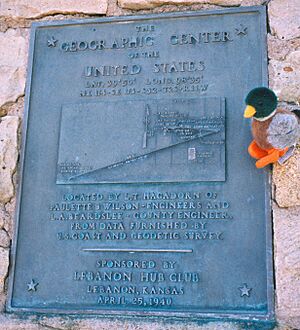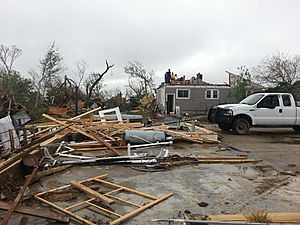Lebanon, Kansas facts for kids
Quick facts for kids
Lebanon, Kansas
|
|
|---|---|
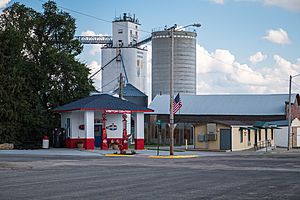
Visitor center (2019)
|
|
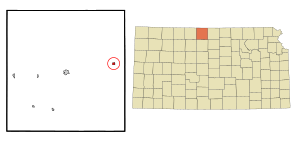
Location within Smith County and Kansas
|
|
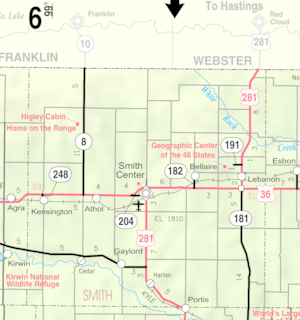
|
|
| Country | United States |
| State | Kansas |
| County | Smith |
| Founded | 1876 |
| Incorporated | 1889 |
| Named for | Lebanon, Kentucky |
| Government | |
| • Type | Mayor–Council |
| Area | |
| • Total | 0.32 sq mi (0.84 km2) |
| • Land | 0.32 sq mi (0.84 km2) |
| • Water | 0.00 sq mi (0.00 km2) |
| Elevation | 1,844 ft (562 m) |
| Population
(2020)
|
|
| • Total | 178 |
| • Density | 556/sq mi (211.9/km2) |
| Time zone | UTC−6 (CST) |
| • Summer (DST) | UTC−5 (CDT) |
| ZIP Code |
66952
|
| Area code | 785 |
| FIPS code | 20-39100 |
| GNIS ID | 2395665 |
Lebanon is a small city in Smith County, Kansas, United States. In 2020, about 178 people lived there.
Contents
History of Lebanon
Lebanon was first started in 1876. It was built about 4 miles (6.4 km) from where it is now. The city moved to its current spot around 1887 or 1888. Lebanon got its name from Lebanon, Kentucky.
The Geographic Center of the United States
In 1918, scientists found something special near Lebanon. They figured out that the geographic center of the 48 connected US states is about 2.6 miles (4.2 km) northwest of the city. This means it's the middle point of the main part of the United States.
A monument was later built at this spot to mark it. The center for all 50 US states (including Alaska and Hawaii) is in Belle Fourche, South Dakota.
Geography and Climate
Lebanon covers a total area of about 0.316 square miles (0.818 square kilometers). All of this area is land.
The city has experienced some very cold weather. On February 13, 1905, the temperature dropped to -40°F (-40°C). This is the coldest temperature ever recorded in Kansas!
Things to See in Lebanon
- Geographic center of the contiguous United States: Visit the monument marking the center of the lower 48 states.
- Kansas Historical Marker – The Geographic Center: Learn more about this important spot.
Population Changes Over Time
| Historical population | |||
|---|---|---|---|
| Census | Pop. | %± | |
| 1890 | 301 | — | |
| 1900 | 590 | 96.0% | |
| 1910 | 731 | 23.9% | |
| 1920 | 822 | 12.4% | |
| 1930 | 723 | −12.0% | |
| 1940 | 652 | −9.8% | |
| 1950 | 610 | −6.4% | |
| 1960 | 583 | −4.4% | |
| 1970 | 517 | −11.3% | |
| 1980 | 440 | −14.9% | |
| 1990 | 364 | −17.3% | |
| 2000 | 303 | −16.8% | |
| 2010 | 218 | −28.1% | |
| 2020 | 178 | −18.3% | |
| U.S. Decennial Census | |||
Lebanon's population has changed a lot over the years. In 1920, it had its highest population with 822 people. Since then, the number of people living in Lebanon has slowly decreased. By 2020, the population was 178.
Who Lives in Lebanon?
In 2020, there were 178 people living in Lebanon. Most residents, about 93%, were white. A small number of people were black, Native American, or from two or more races. About 3% of the population was Hispanic or Latino.
The average age of people in Lebanon was 58 years old. About 14.6% of the population was under 18 years old. Many people, about 31.5%, were 65 years or older.
Understanding Rural Flight
Lebanon has been part of studies about "rural flight." This is when people move away from small towns and rural areas to bigger cities. This can cause challenges for small communities like Lebanon, as their populations get smaller.
Education in Lebanon
The local schools in Lebanon are part of the Smith Center USD 237 public school district.
Years ago, Lebanon had its own schools, but they closed due to school unification. The Lebanon Bronchos (or Broncos) were a successful high school basketball team. They won the Kansas State High School boys 1A basketball championship in 1977.
See also
 In Spanish: Lebanon (Kansas) para niños
In Spanish: Lebanon (Kansas) para niños


